Study on Stability and Deformation Characteristics of Ultra-Deep Diaphragm Wall during Trench Excavation
Abstract
:1. Introduction
2. Engineering Background
2.1. Project Overview
2.2. Engineering Geological Conditions
3. Analysis of Two-Dimensional Wedge Failure Model for Groove Trench Stability
3.1. The Horizontal Strip Method
- (1)
- The failure model is a wedge destruction along a linear sliding surface;
- (2)
- The strata are horizontal and the strata interfaces are perpendicular to the groove surface;
- (3)
- Destruction is an instantaneous process.
3.2. Parameters in Calculation
- (1)
- The characteristics of the foundation soil;
- (2)
- The properties of the mud, including its composition, severity, and height;
- (3)
- The underground water level;
- (4)
- The grooving method;
- (5)
- Construction-related factors, such as mechanical vibrations, construction sequence, and overloading.
3.3. Calculation Results
4. Numerical Analysis of Deformation Characteristics of Strata during the Process of Groove Construction
4.1. Numerical Model
- (1)
- Under the initial constraint boundary and hydrological boundary conditions, the model calculates to equilibrium. At this point, displacements are reset to zero.
- (2)
- An upper overload of 20 kPa is applied to the model surface and the analysis is performed until an equilibrium state is achieved, then the displacements are cleared and set back to zero. This step simulates the application of construction loads before the excavation of the groove wall.
- (3)
- The soil in the groove trench is excavated according to the actual formation of the diaphragm wall groove, and slurry pressure is applied simultaneously on the groove lateral (simulating slurry pressure by applying lateral pressure on the trench sidewalls) groove.
- (4)
- The soil in the groove is excavated sequentially, following the same procedure as in Step 3. The process is repeated until the entire excavation is completed.
4.2. Analysis of X-Direction Deformation Characteristics of Groove Trench (Long Side)
4.3. Analysis of Y-Direction Deformation Characteristics of Groove Trench (Short Side)
4.4. Analysis of Y-Direction Deformation Characteristics of Groove Trench (Short Side)
4.5. Analysis of Z-Direction Deformation Characteristics of Surface
5. Conclusions
- (1)
- The stability of the diaphragm wall groove trench in this project was analyzed using the two-dimensional wedge horizontal strip method. Through calculations, it was determined that the mud weight required to ensure the stability of the groove trench is approximately 12.70 kN/m3 (Stratum 1) and 12.64 kN/m3 (Stratum 2). These values are slightly higher than the actual maximum mud weight of 12.5 kN/m3. The results highlight the effectiveness of the horizontal strip method in accurately determining the required mud weight.
- (2)
- The mud weight and mud level elevation significantly impact the critical fracture angle and stability coefficient of the groove trench. A higher mud weight and elevated slurry surface lead to a relatively larger stability coefficient. The findings emphasize the importance of considering the mud weight and mud level in ensuring the stability of the groove trench.
- (3)
- On the long side of the groove trench, soil deformation decreases as the distance from the wall increases. When the distance exceeds 6m, the maximum deformation at the lower part of the groove trench tends to stabilize, with a significant reduction in the rate of deformation. In this project, the excavation width of the groove trench is 6.5m. The soil within the range of groove trench long side size is heavily influenced, while the impact diminishes beyond this range. On the short side of the groove trench, the deformation fluctuation is relatively small compared to the long side.
- (4)
- Considering the combined effect of the dimensional differences and the soil arching, the soil around the groove of the ultra-deep diaphragm wall does not simply move toward the groove, which shows three distinct deformation modes.
Author Contributions
Funding
Data Availability Statement
Conflicts of Interest
Nomenclature
| FS | safety factors based on the horizontal strip method; |
| FSmin | the minimum value of FS; |
| sliding surface inclination; | |
| θcr | the corresponding angle θ to the FSmin; |
| c′(i) | the effective cohesion of strip i, each strip represents a layer of soil; |
| φ′(i) | the effective internal friction angle of strip i; |
| l(i) | the length of slide surface of strip i; |
| W(i) | the dead weight of strip i; |
| Fn(i) | the vertical force acting on the upper side of strip i, downward is positive; |
| Fs(i) | the shear force acting on the upper side of strip i, right is positive; |
| Ps(i) | the horizontal slurry force acting on the left side of strip i, right is positive; |
| U(i) | the water pressure acting on the sliding surface of strip i; |
| Fn(i + 1) | the vertical force acting on the downward side of strip i, upward is positive; |
| Fs(i + 1) | the shear force acting on the downward side of strip i, left is positive; |
| N(i) | sliding surface normal force of strip i; |
| T(i) | sliding surface sheer force of strip i. |
References
- Zhang, L. Study on construction technology of three walls unified into one for underground diaphragm wall. Build. Constr. 2009, 31, 161–164. [Google Scholar]
- Liu, Y.T.; Xu, W.; Guo, H.G. Excavation simulation of super deep foundation pit braced by circular rock-socketed diaphragm wall. J. Fujian Univ. Technol. 2004, 1, 39–43. [Google Scholar] [CrossRef]
- Yang, G.H. Practical calculation method of retaining structures for deep excavations and its application. Rock Soil Mech. 2004, 12, 1885–1896, 1902. [Google Scholar] [CrossRef]
- Li, F. Studies on circle-style retaining structures. Chin. J. Geotech. Eng. 2006, S1, 1522–1524. [Google Scholar] [CrossRef]
- Zhai, J.Q.; Wang, Q.; Wang, S.S.; Zhang, Z.B.; Wan, J.C. Design, construction, and monitored behavior of two large-diameter cylindrical diaphragm walls on an offshore reclamation island. In IOP Conference Series: Earth and Environmental Science; IOP Publishing: Bristol, UK, 2024; Volume 1336, p. 012016. [Google Scholar] [CrossRef]
- Cao, H.R.; Peng, L.M.; Lei, M.F.; Tang, Q.L. Research Status of the Instability Mode and its Stability Calculation Method of Underground Diaphragm Wall. J. Railw. Sci. Eng. 2019, 16, 1743–1748. [Google Scholar] [CrossRef]
- Xia, Y.Y.; Pei, Y.Y.; Wang, Z.; Chen, S.Y.; Chen, C. Numerical Simulation of Stress Redistribution During Diaphragm Wall Construction. Rock Soil Mech. 2012, 33, 3433–3438. [Google Scholar] [CrossRef]
- Dong, Y.; Whittle, A.J. Effect of concreting pressure on ground response caused by installation of diaphragm wall panels. Géotechnique 2022, 74, 81–98. [Google Scholar] [CrossRef]
- Yang, M.; Lu, J.Y. Estimation of Ground Settlement Aroused by Deep Excavation. Chin. J. Geotech. Eng. 2010, 32, 1821–1828. [Google Scholar]
- Zhao, H.; Shen, X.; Jia, P.; Zhou, X. Diaphragm Wall Deformation Behavior and Inclinometer Data Analysis for Braced Deep Excavations. Int. J. Geomech. 2024, 24, 04024092. [Google Scholar] [CrossRef]
- Lei, G.H.; Wang, X.; Lei, G.G. Stability Influencing Factors and Instability Mechanism of Slurry-supported Excavations. Adv. Sci. Technol. Water Resour. 2006, 26, 82–86. [Google Scholar] [CrossRef]
- Lei, G.H.; Wang, X.; Lei, G.G. Sliding Wedge Shape and Analysis Method of Global Stability of Rectangular Excavated Trenches. J. Southeast Univ. (Nat. Sci. Ed.) 2006, 1, 102–106. [Google Scholar] [CrossRef]
- Xia, Y.Y.; Pei, Y.Y.; Wang, Z.D. Horizontal Slice Method for Stability of Slurry Trench. Chin. J. Geotech. Eng. 2013, 35, 1128–1133. [Google Scholar]
- Ahmed, A.; Ugai, K.; Yang, Q.Q. Assessment of 3D Slope Stability Analysis Methods Based on 3D Simplified Janbu and Hovland methods. Int. J. Geomech. 2018, 12, 81–89. [Google Scholar] [CrossRef]
- Yi, A.F. Calculation Method of Slurry Volume-weight During Trenching Construction of Diaphragm Wall. J. Railw. Sci. Eng. 2017, 14, 1019–1023. [Google Scholar] [CrossRef]
- Miao, Y.B.; Jiang, S.; Huang, M.; Huang, X.; Shen, Q.W. Local Stability Calculation and Factors of Slurry Trench With Strength Reduction Method. J. Eng. Geol. 2017, 26, 874–880. [Google Scholar] [CrossRef]
- Meng, D.P. Stability Analysis of Slurry Trench of Diaphragm Based on Strength Reduction Finite Element Method. Geotech. Eng. Tech. 2018, 32, 69–73. [Google Scholar]
- Mrton, K.; Cater, R.W.; Linney, L. Observed Settlements of Buildings Adjacent to Stations Constructed for the Modified Initial System of the Mass Transit Railway, Hong Kong. In Proceedings of the 6th Southeast Asian Conference of Soil Engineering, Taipei, Taiwan, 19–23 May 1980; pp. 415–429. [Google Scholar]
- Poh, T.Y.; Wong, I.H. Effects of Construction of Diaphragm Wall Panels on Adjacent Ground: Field Trial. J. Geotech. Geoenviron. Eng. 1998, 124, 749–756. [Google Scholar] [CrossRef]
- Ou, Z.Y. Analysis and Design Theory and Practice of Deep Excavation Engineering; Science and Technology Books Limited Company: Taibei, Taiwan, 2004. [Google Scholar]
- Pei, Y.J.; Zheng, G.; Liu, J.Q. Model test and numerical analysis of diaphragm wall with hinged joints on both sides. Rock Soil Mech. 2008, 29, 279–284. [Google Scholar] [CrossRef]
- Liu, M. Structural performance of the deep foundation pit bracing with circular diaphragm wall. J. Highw. Transp. Res. Dev. 2005, 22, 100–103, 118. [Google Scholar]
- Chen, F.Q.; Yang, G.H.; Zhang, Y.C.; Yao, L.N. Discussion on value of coefficient α in structural design of circular diaphragm wall. Chin. J. Geotech. Eng. 2012, 34, 203–206. [Google Scholar]
- Shen, J.; Wang, W.D.; Weng, Q.P. Analytic method of diaphragm walls of circular foundation pits. Chin. J. Geotech. Eng. 2008, 30, 280–285. [Google Scholar]
- Pei, Y.Y.; Xia, Y.Y.; Zhou, Z.Y.; Wang, Z.D.; Zhou, X. Analytical Solution for Horizontal Stress and Displacement Distribution Due to Diaphragm Wall Construction. J. Wuhan Univ. Technol. 2014, 36, 103–108. [Google Scholar]
- Britto, A.M.; Kusakabe, O. Stability of unsupported axisymmetric excavations in soft clay. Géotechnique 1982, 32, 261–270. [Google Scholar] [CrossRef]
- Toyosawa, Y.; Horii, N.; Tamate, S. Analysis of fatal accidents caused by trench failure. Int. Conf. Case Hist. Geotech. Eng. 1993, 2, 751–758. [Google Scholar]
- Oblozinsky, P.; Ugai, K.; Katagiri, M.; Saitoh, K.; Ishii, T.; Masuda, T.; Kuwabara, K. A design method for slurry trench wall stability in sandy ground based on the elasto-plastic fem. Comput. Geotech. 2001, 28, 145–159. [Google Scholar] [CrossRef]
- Xu, Y.G.; Wei, Z.L.; Zhou, G.N.; Sun, Y.Y. Analysis of stability of slurry trench sides of diaphragm wall based on construction parameters. Chin. J. Rock Mech. Eng. 2011, 30, 3464–3470. [Google Scholar]
- Xu, Q.; Xie, J.; Sun, Z.; Lu, L.; Yu, H. Stability Analysis of Trench Wall for Diaphragm Wall in Ultra-Deep Circular Foundation Pit: A Comprehensive Investigation. Appl. Sci. 2023, 13, 12037. [Google Scholar] [CrossRef]
- An, C.L.; Feng, W.X.; Zhao, Q.H.; Ji, L.L.; He, D.L.; He, B.G. Local Stability of Trench for Diaphragm Walls Passing through Deep Weak Interlayer. Adv. Mater. Sci. Eng. 2021, 2021, 9934516. [Google Scholar] [CrossRef]
- Gunn, M.J.; Satkunananthan, A.; Clayton, C.R.I. Finite element modelling of installation effects. In Retaining Structures: Proceedings of the Retaining Structures Conference held at Robinson College, Cambridge, Thomas Telford 1992; Thomas Telford Publishing: London, UK, 1993; pp. 46–55. [Google Scholar]
- Ng, C.W.W.; Springman, S.M.; Norrish, A.R.M. Centrifuge Modeling of Spread-Base Integral Bridge Abutments. J. Geotech. Geoenviron. Eng. 1998, 124, 376–388. [Google Scholar] [CrossRef]
- Gourvenec, S.M.; Powrie, W. Three dimensional finite element analysis of diaphragm wall excavation. Géotechnique 1999, 49, 801–823. [Google Scholar] [CrossRef]
- Ning, J.; Yu, J.; Huang, M. Effect of slurry infiltration on trench stability of diaphragm wall. In Proceedings of the Eleventh International Symposium on Geotechnical Aspects of Underground Construction in Soft Ground, Macao, China, 14–17 June 2024; pp. 190–197. [Google Scholar]
- Pei, Y.Y. The Environmental Effect of Diaphragm Wall Panel Construction; Wuhan University of Technology: Wuhan, China, 2013. [Google Scholar]


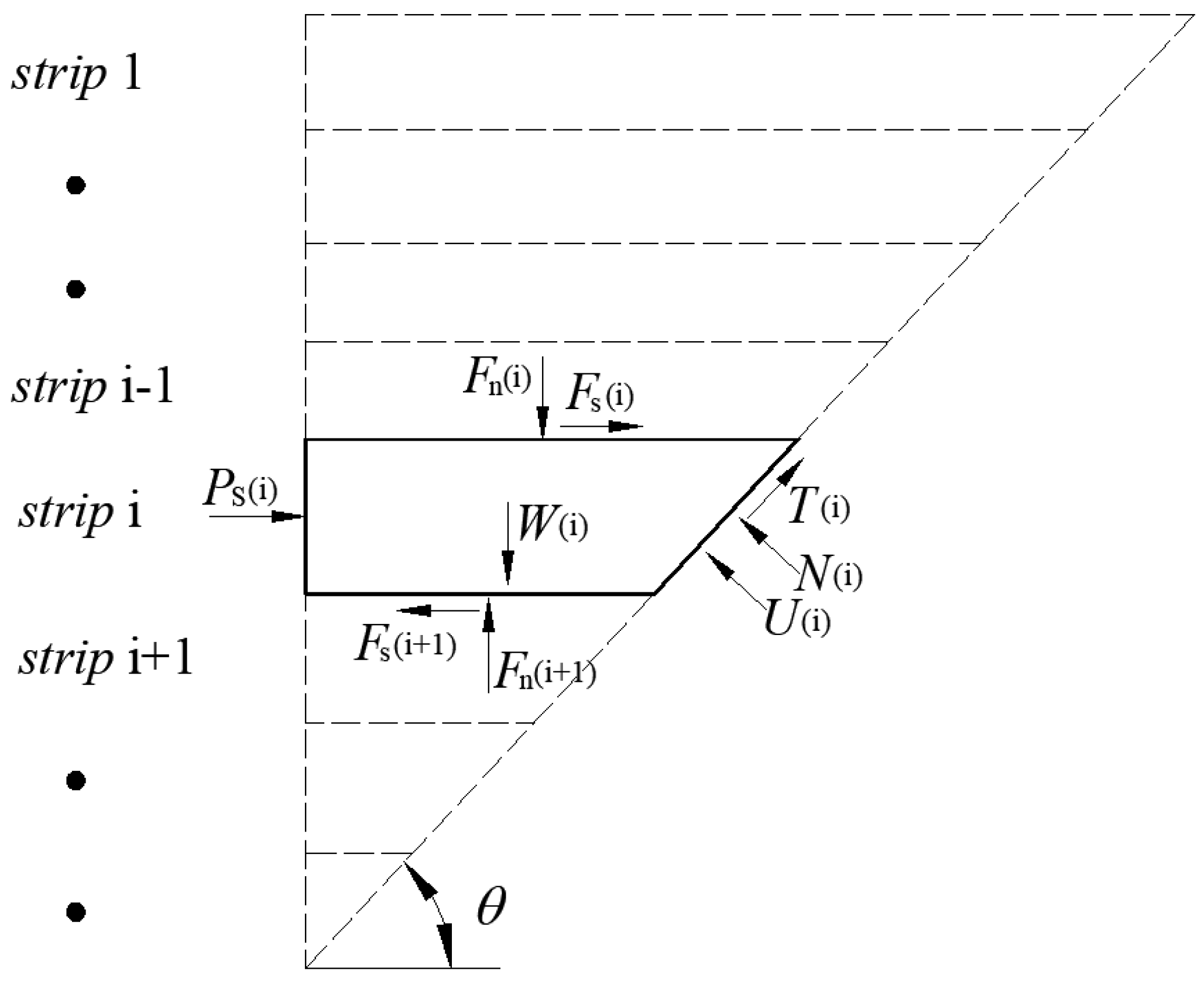
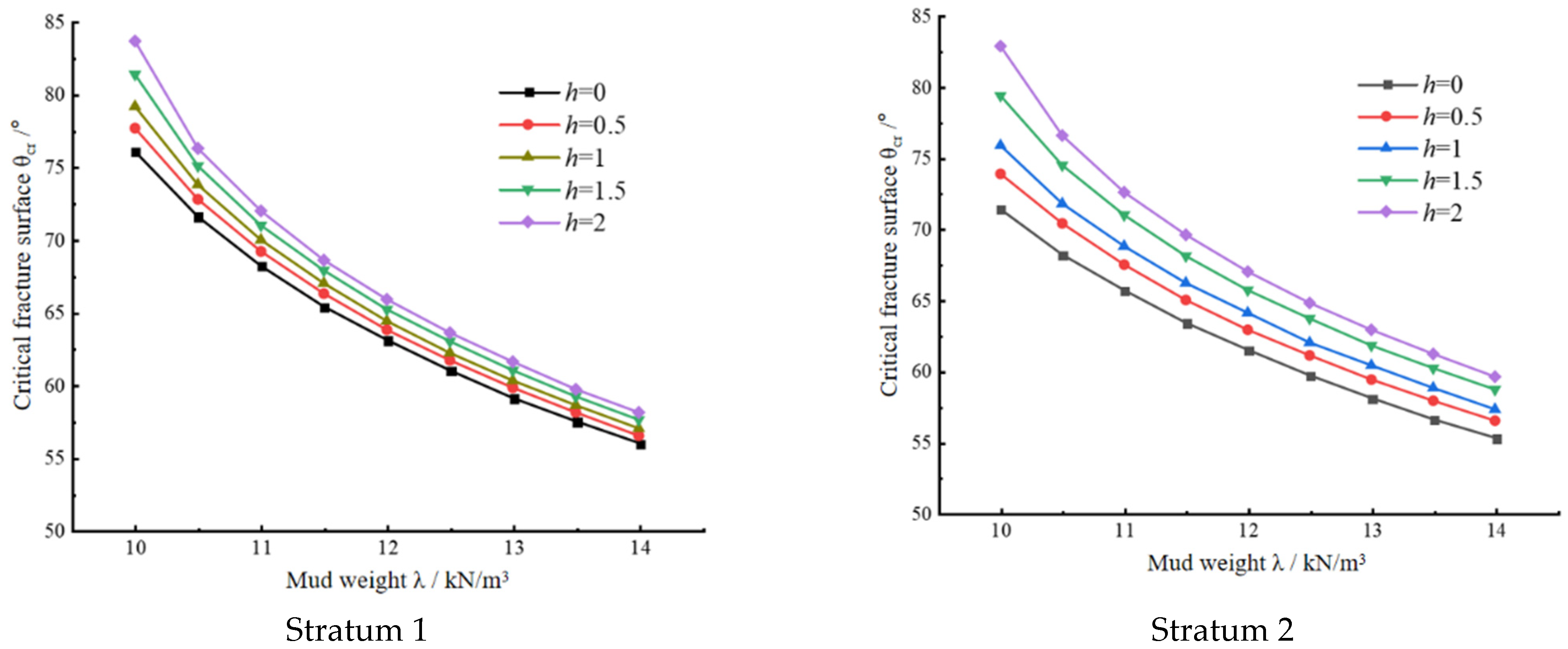




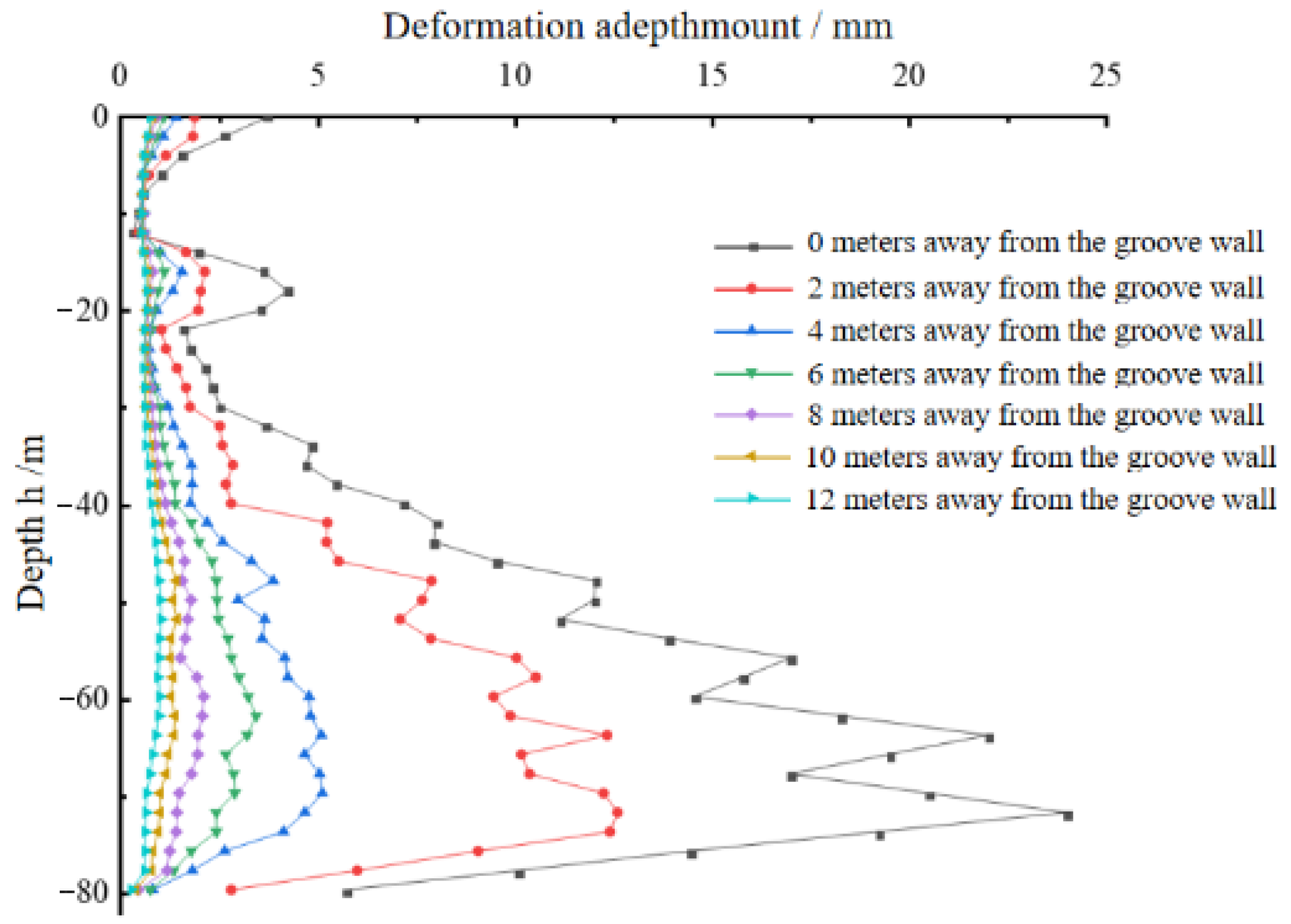


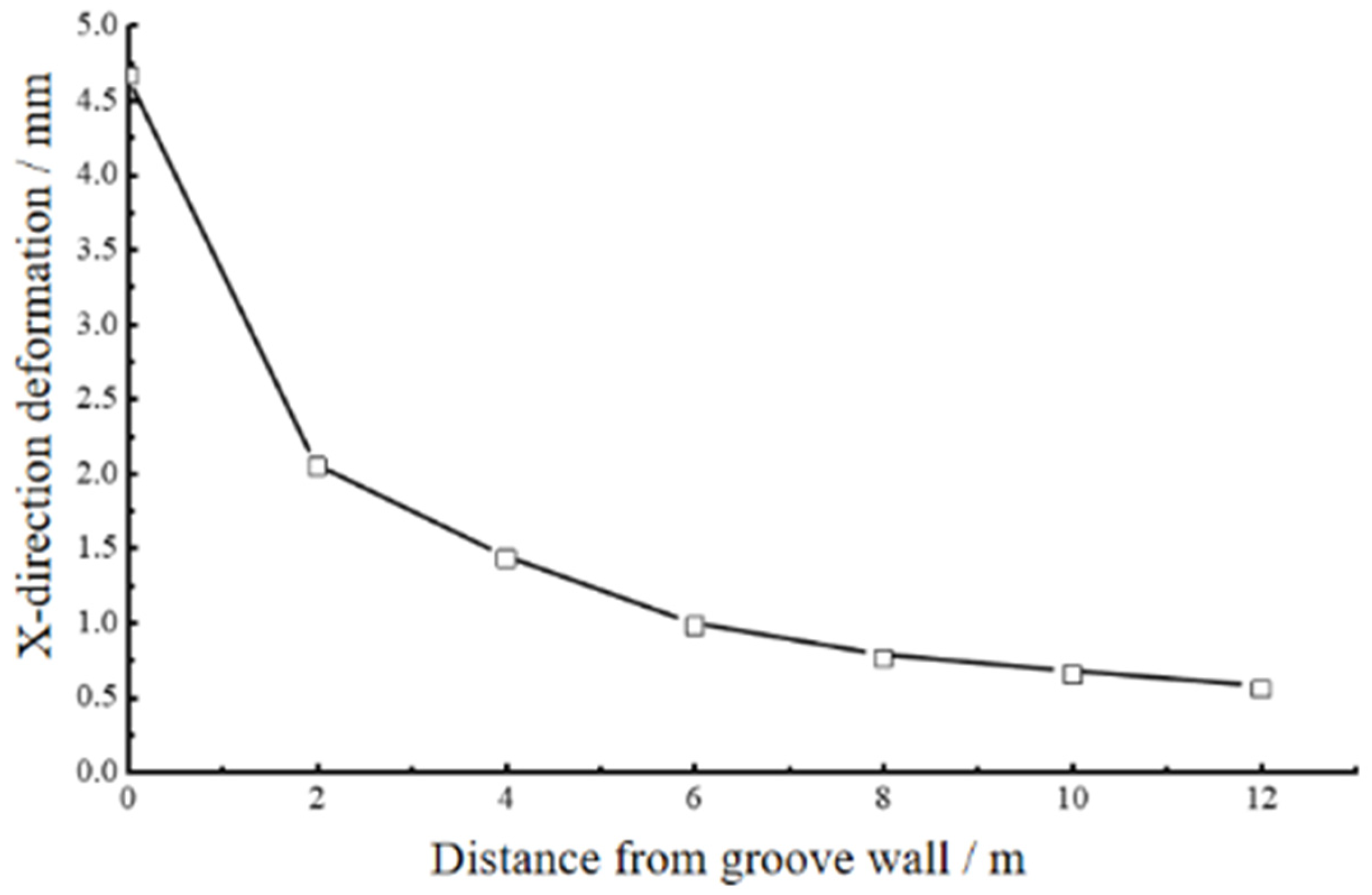
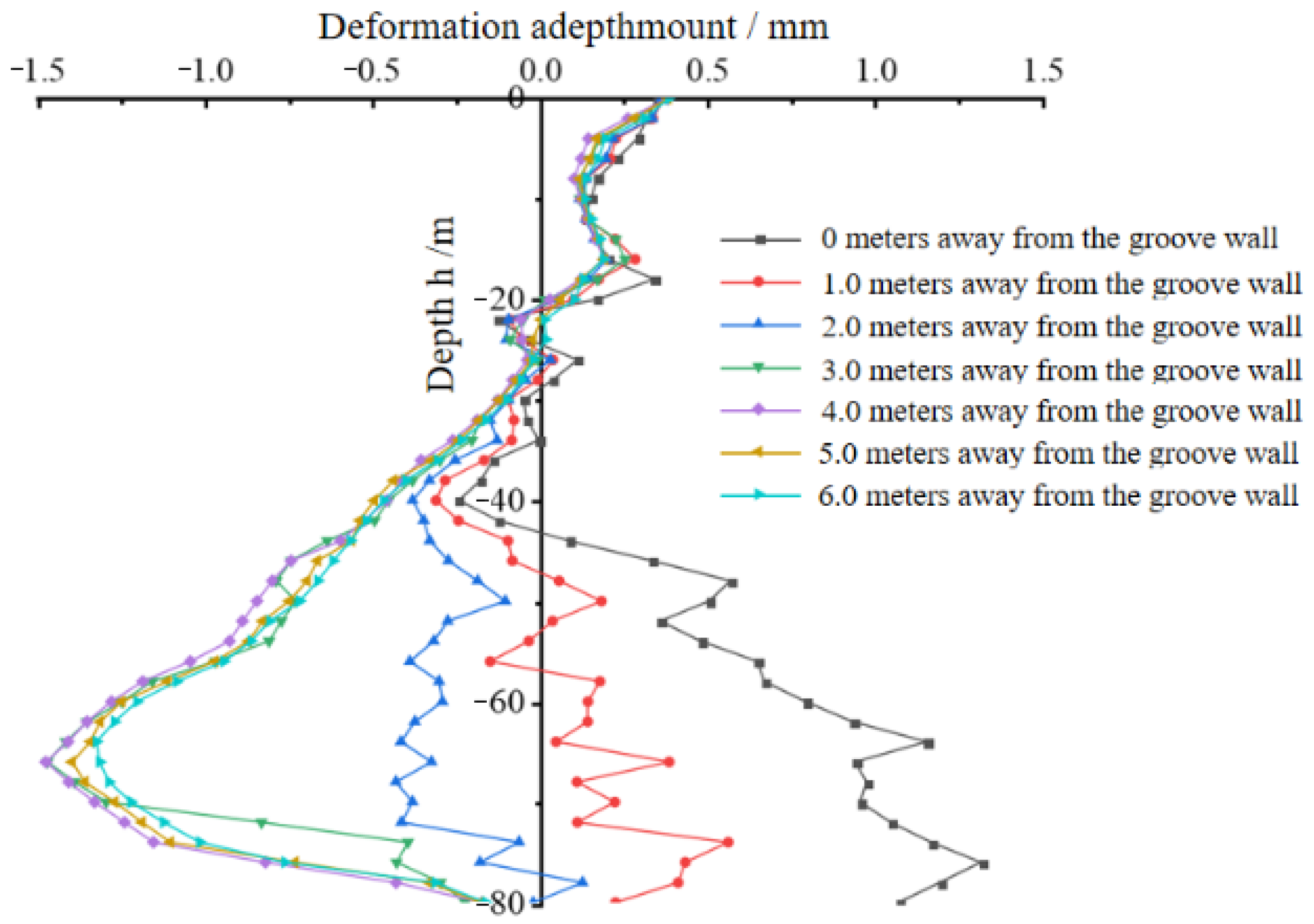

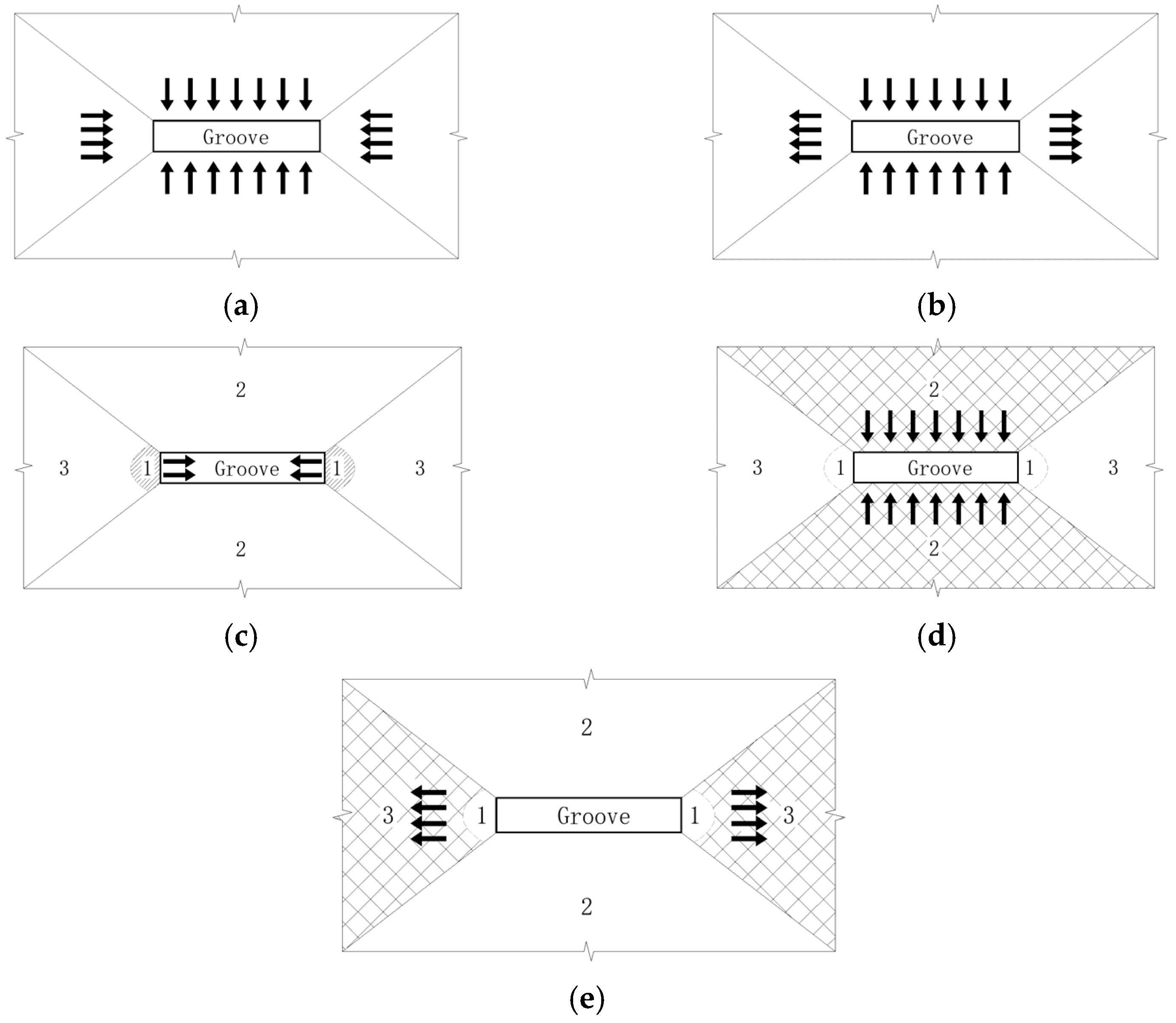

| Foundation Pit Numbering | Diameter (m) | Depth (m) | Form of Support |
|---|---|---|---|
| WIP01 | 28 | 67.7 | Diaphragm wall + ring inner brace |
| WIP12 | 47.4 | 69.1 | Diaphragm wall + ring inner brace; bolt + shotcrete |
| WDP01 | 38 | 78.2 | Diaphragm wall + ring inner brace |
| WDP12 | 55.4 | 79.1 | Diaphragm wall + ring inner brace; bolt + shotcrete |
| WDP22 | 55.4 | 79.1 | Diaphragm wall + ring inner brace; bolt + shotcrete |
| Stratum | Density γ (kN/m3) | Cohesion c (kPa) | Internal Friction Angle ϕ (°) | Permeability Coefficient k (Micrometer/s) | Modulus E (MPa) |
|---|---|---|---|---|---|
| Artificial filler | 18.5 | 0 | 30 | 1.00 × 10−1 | 10 |
| Marine clay | 16.5 | 0 | 22 | 1.00 × 10−3 | 11 |
| Fully weathered~strongly weathered argillaceous siltstone | 19~20 | 3~5 | 31~33 | 1.00 × 10−1 | 40~150 |
| Weathered~slightly weathered argillaceous siltstone | 25 | 330 | 35 | 1.00 × 10−1 | 6000 |
| Height h(m) | 0 | 0.5 | 1 | ||||||
|---|---|---|---|---|---|---|---|---|---|
| Density λ (kN/m3) | θcr | FSmin | θcr | FSmin | θcr | FSmin | |||
| 10 | 76.1 | 0.310712 | 77.7 | 0.270062 | 79.2 | 0.233697 | |||
| 10.5 | 71.6 | 0.442075 | 72.8 | 0.406029 | 73.8 | 0.375807 | |||
| 11 | 68.2 | 0.563956 | 69.2 | 0.52755 | 70 | 0.497722 | |||
| 11.5 | 65.4 | 0.686442 | 66.3 | 0.647492 | 67 | 0.616014 | |||
| 12.0 | 63.1 | 0.814992 | 63.8 | 0.771867 | 64.4 | 0.73736 | |||
| 12.5 | 61 | 0.953976 | 61.7 | 0.905033 | 62.2 | 0.866197 | |||
| 13 | 59.1 | 1.107826 | 59.8 | 1.051131 | 60.3 | 1.006503 | |||
| 13.5 | 57.5 | 1.281715 | 58.1 | 1.214813 | 58.6 | 1.162572 | |||
| 14 | 56 | 1.482261 | 56.5 | 1.401837 | 57 | 1.339578 | |||
| Height h(m) | 0 | 0.5 | 1 | 1.5 | 2 | ||||||||
|---|---|---|---|---|---|---|---|---|---|---|---|---|---|
| Density λ (kN/m3) | θcr | FSmin | θcr | FSmin | θcr | FSmin | θcr | FSmin | θcr | FSmin | |||
| 10 | 71.4 | 0.425646 | 73.9 | 0.363107 | 75.9 | 0.312029 | 81.4 | 0.1835 | 83.7 | 0.13129 | |||
| 10.5 | 68.2 | 0.53395 | 70.4 | 0.491137 | 71.8 | 0.442419 | 75.1 | 0.33811 | 76.3 | 0.30542 | |||
| 11 | 65.7 | 0.642724 | 67.5 | 0.602533 | 68.8 | 0.555303 | 71 | 0.46158 | 72 | 0.43133 | |||
| 11.5 | 63.4 | 0.756268 | 65 | 0.711735 | 66.2 | 0.666807 | 67.9 | 0.57844 | 68.6 | 0.54754 | |||
| 12 | 61.5 | 0.877968 | 62.9 | 0.823258 | 64.1 | 0.781821 | 65.2 | 0.6966 | 65.9 | 0.663462 | |||
| 12.5 | 59.7 | 1.011192 | 61.1 | 0.953125 | 62 | 0.906329 | 63 | 0.82072 | 63.6 | 0.78408 | |||
| 13 | 58.1 | 1.159748 | 59.4 | 1.094443 | 60.4 | 1.038119 | 61 | 0.94566 | 61.6 | 0.913232 | |||
| 13.5 | 56.6 | 1.328329 | 57.9 | 1.252773 | 58.8 | 1.19026 | 59.2 | 1.10236 | 59.7 | 1.054626 | |||
| 14 | 55.3 | 1.523044 | 56.5 | 1.436519 | 57.3 | 1.362364 | 57.6 | 1.26842 | 58.1 | 1.212454 | |||
Disclaimer/Publisher’s Note: The statements, opinions and data contained in all publications are solely those of the individual author(s) and contributor(s) and not of MDPI and/or the editor(s). MDPI and/or the editor(s) disclaim responsibility for any injury to people or property resulting from any ideas, methods, instructions or products referred to in the content. |
© 2024 by the authors. Licensee MDPI, Basel, Switzerland. This article is an open access article distributed under the terms and conditions of the Creative Commons Attribution (CC BY) license (https://creativecommons.org/licenses/by/4.0/).
Share and Cite
Ma, J.; Hu, G.; Rui, R.; Ding, R.; Sun, T. Study on Stability and Deformation Characteristics of Ultra-Deep Diaphragm Wall during Trench Excavation. Buildings 2024, 14, 2227. https://doi.org/10.3390/buildings14072227
Ma J, Hu G, Rui R, Ding R, Sun T. Study on Stability and Deformation Characteristics of Ultra-Deep Diaphragm Wall during Trench Excavation. Buildings. 2024; 14(7):2227. https://doi.org/10.3390/buildings14072227
Chicago/Turabian StyleMa, Jianhua, Gang Hu, Rui Rui, Ruiheng Ding, and Tianjian Sun. 2024. "Study on Stability and Deformation Characteristics of Ultra-Deep Diaphragm Wall during Trench Excavation" Buildings 14, no. 7: 2227. https://doi.org/10.3390/buildings14072227




